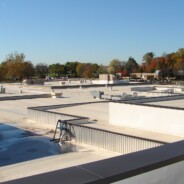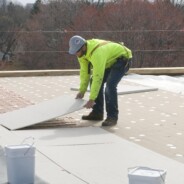Building Codes
Roof inspections should be top of mind before winter sets in
It may seem like last winter ended not too long ago, but the reality is that fall is quickly coming to an end, and colder temperatures and harsh weather are not far off. As a building owner or facility manager, planning for winter’s ice and snow starts at the top: The roofing membrane serves as the first line of defense against the elements. For roofing professionals, this is an opportunity to be a proactive partner with customers. While internal staff may be tasked with performing basic roof inspections throughout the year, it is always a good precaution to hire a roofing professional for a detailed inspection before the weather turns. This can prevent minor roofing issues from becoming major concerns. A close-up...
read moreJust how strong is your commercial roof
The roof is often times your building’s first layer of defense against the weather elements, standing up to extreme UV light, heavy snow, and rain. Even a regular maintenance trip to the roof can result in something being dropped on the surface. Common punctures to your roof can happen in a variety of ways with objects hitting the roof at high and low rates of speed. Single-ply membranes do not have a hard exterior layer, so they may seem less resistant to damage on the surface, but many factors go into selecting the right roofing membrane that will stand the test of time. To help ensure your roof is up to par, your roofing contractor will generally work with their roofing distributor, the general contractor, and the...
read moreGenFlex helps clear the air on VOCs
“Green” means many things to many people. For building owners, it typically refers to the energy efficiency of a building. For general contractors, it can indicate the sustainability of products and practices. For architects, it sometimes represents the impact of construction on the surrounding ecosystem. And for roofers, we often think of “green” as the amount of Volatile Organic Compounds (VOCs) in the products we use. It’s estimated that more than 80,000 chemicals are commonly used in construction around the world, and there’s a growing backlash against potentially toxic additives like VOCs – a class of chemicals whose emissions can exacerbate respiratory illnesses like asthma. If you’re a construction...
read moreProper training and education are essential to prevent roofing accidents
Currently, accidental falls are the leading cause of death and serious injury for roofing workers. Many accidents can be prevented with the use of proper safety measures and training. During a two-year period, California’s OSHA conducted investigations into 126 accidents from roofing operations and found that three out of every four accidents occurred at operations where there was a violation of state safety regulations. In an effort to increase safety on the job, OSHA is launching a safety awareness campaign specifically designed for roofers. Staying up to date on OSHA’s workplace safety regulations can help prevent both safety violations and injuries on the job. Learn more about OSHA’s general guidelines...
read moreSpring is just around the corner, roof inspections should be top of mind
The worst of winter appears to be behind us, and now is the time to start focusing on preventative roofing maintenance. Snow falls were extremely heavy in many parts of the country; with spring precipitation on the way, this is the time to address minor concerns before they become major problems. In general, it is recommended to perform at least two roof inspections a year. Your roof inspection should start with the basics, including clearing any debris off the roof that is left over from winter. In the case of TPO and other reflective membranes, this cleaning can be especially important in areas with hot, sunny summers. Clearing away dirt and discoloration maintains white roofs’ solar reflectance and energy efficiency; an...
read moreBuilding codes continuously improving energy efficiency standards
The trend of increasing commercial building energy efficiency is not going away anytime soon. More regulations and building codes are setting new standards for new construction projects. Energy efficiency is important to a building’s long-term maintenance and operating costs, making it extremely important to building owners and facility managers. In 2014, the Polyisocyanurate Insulation Manufacturers Association (PIMA) increased the Long Term Thermal Resistance (LTTR) values of polyiso roof insulation. Changes became a priority after more advanced testing methods were adopted that better predicted thermal performance over time. The changes to LTTR values came about in order to provide a comprehensive approach resulting in...
read moreAs kids head back to school, GenFlex puts roofing on the lesson plan
As hard as it is to believe, fall is here – across the country, most kids have finished mourning the end of summer vacation and have settled into the routine of a new school year. For more than 14 million students in our K-12 public schools, the fall semester means coming back to a building that doesn’t meet basic construction codes, is overcrowded, or both. As parents, this is cause for alarm – as part of the commercial roofing industry, it’s also an opportunity. There are roughly 100,000 public elementary and secondary school buildings in the U.S. (and as many as 35,000 more private K-12 schools). The National Center for Education Statistics and U.S. General Accounting Office have estimated that at least a third of...
read more






